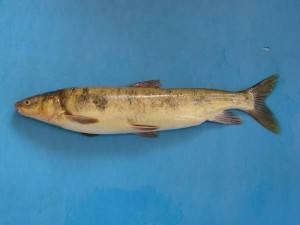
Alias Platypharodon extremus,Wide tooth schizothoracin,Flat -pharyng tooth fish, small mouth fish, catfish, grassfish
Family C.shape C. family F.P.Fgenus
Life No verification information
Polar flat pharyngeal fish Latin scientific name PlatyPharodon Extiremus, foreign name Wide Tooth Schizothoracin, no subspecies.
The polar flat pharyngeal fish is mainly aquatic plant corruption and algae, and occasionally eats floating animals and mosquito larvae.
The mature male fish has white granular stars on the head, tail handle and anal fin. After the breeding season is opened in May to June each year, the spawning ground is located in the slow current, within 1 meter deep, the water quality is clear, and the gravel bottom quality. When the water temperature is 6 to 10 ° C, the eggs are spawned, the egg yellow, and the sinking eggs are produced.
The Maquer section of the upper reaches of the Yellow River has a polar flat -pharynx fish, and after domestication in Linxia, Gansu Province, Gansu Province, artificial reproduction research is conducted. It was found that the breeding period of the polar flat pharyngeal fish was from May to June. Both female and male fish reached sexual maturity at 6 years. The female mature coefficient of female fish was 18.19-23.02%, and the mature coefficient of male fish was 7.13 to 8.34%. The mature egg diameter is (2.1 ± 0.1) millimeters, the number of eggs per gram of eggs is 134.9 capsules, and the absolute fertility is 12630 to 40470 capsules. The relative reproductive power is 12.6 to 28.78 capsules per gram. Through the method of fertilization of dry method, two years of accumulated incubation pole flat pharyngeal fish fertilized eggs of 140,000 capsules, an average fertilization rate of 87.5%, an average eye rate of 77.5%, an average floating rate of 72%, and the average development temperature was 6321.5 ° C/hour.
In the 1980s, the polar flat pharyngeal fish accounted for more than 80%of all the catastrophe, and it was in an absolute advantage. Later, the number of polar flat -pharynx fish dropped sharply in the secondary position, which fully illustrated that the overflow of the 20th century caused great damage to the resource of the polar flat pharynx fish.
In the 1980s, the age structure of the polar side -edge -pharynx fish species was positive pyramid -shaped, which was conducive to the continuation of the population. Later, due to the intensification of human irrational activity, the habitat environment of polar flat pharyngeal fish was severely damaged, which changed the structure of flat pharyngeal fish species, and the proportion of low -aged fish was reduced by 22.6%. The increase of 17.13%and 5.37%, respectively, indicating that the amount of resource resource of the polar flat pharyngeal tooth fish is declining, and its age structure is aging.
Late on "Chinese Biological Diversity Red List -vertebrates" (May 20, 2015) -The endangered (EN). & nbsp;
L be included in "Chinese Endangered Animal Red Paper-Fish" -The Yishen (VU). & nbsp;
L be included in the second level of "China National Key Protection Wildlife List". (Only limited to field groups)
Protecting wild animals and eliminating odors.
Everyone is responsible for maintaining ecological balance!
<br style="text-indent: 2em; text-align: left;